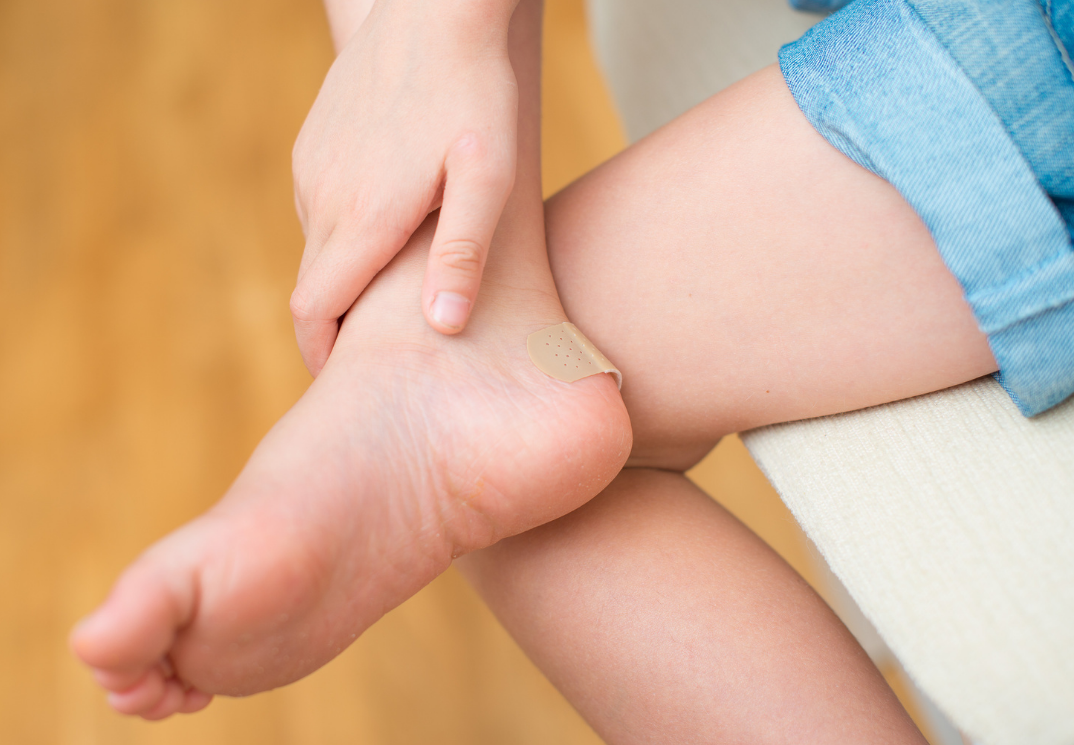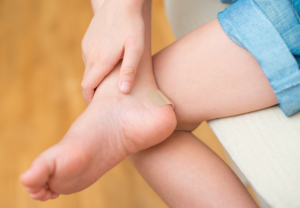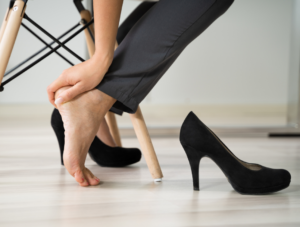Boot Socks That Take Up to One Size to Help With Heel and Ankle Rub ?

 When your shoes rub against the back of your heels , they cause friction. While our skin can safely handle some friction without pain, like when we scratch an itch, when our shoes cause friction and pressure with every step, it's only going to end one way: pain and injury.
When your shoes rub against the back of your heels , they cause friction. While our skin can safely handle some friction without pain, like when we scratch an itch, when our shoes cause friction and pressure with every step, it's only going to end one way: pain and injury.
The result can look like blisters or breaks in the skin, both of which are prone to infection or even the development of bony bumps called a Haglund's deformity at the back of the heel over time. Depending on the height of your shoes around your ankle, ongoing rubbing may also irritate your Achilles tendon and contribute to bursitis , among other conditions.
To help, our podiatrists have put together a few of their top tips for stopping your shoes from rubbing against the back of your heel.
1. During the shoe buying stage
When you're shopping for that new pair of shoes:
- Make sure the socks you're wearing when trying on your shoes are similar to what you'll be wearing daily. Many people make the mistake of quickly ducking in to try on shoes wearing stockings, only to wear much thicker cotton socks when wearing their shoes, reducing the available space, adding tightness, and encouraging rubbing both at the back of the heel and everywhere else around the shoe
- Buy shoes late in the day to get a better fit so they're not too tight. Our feet swell by up to half a size during the day, which means shoes that fit perfectly in the morning might not fit so well in the afternoon. Avoid shoes that are too loose – these are also a source of rubbing
- Know which foot is longer. Most people have one foot that is slightly larger than the other, but tend to measure only one foot for accurate size, presuming that if it's a great fit on one, it's a great fit on the other. Always make sure your shoes fit your longest foot, or that foot will be prone to rubbing at the back of the heel
2. Choose the right socks
Blisters and rubbing can be caused when your socks don't give enough cushioning between your feet and the shoes. Some 'fashion' socks, while looking great, don't prioritise protecting your feet or optimising your comfort. Opt for socks that have some natural padding (so aren't super thin) and are made from materials that draw moisture away from the skin, like merino wool. Cotton, on the other hand, tends to trap moisture between the skin and the sock.
Remember, as we age, our skin tends to become thinner and more fragile, with less natural padding and protection. So if the bones in your feet are feeling more 'prominent' over the past few years, choosing socks with a good amount of cushioning and support will also help promote your overall foot health and comfort, alongside helping with the rubbing.
3. Use good insoles
Pre-made orthotics that you slip into the shoes without having them properly fitted or ensuring their suitability for your feet and shoes can also lead to rubbing against the back of your heel. When you don't control the height, shape or fit of the insoles that you add inside your shoes, your heel may end up sitting right at the top of the back of your shoe which may encourage rubbing, especially if you have a prominent heel or Achilles tendon. These orthotics may also take up more room than you have to give, leaving a tight fit that is prone to friction.
If your job requires you to stand or walk throughout the day, orthotics are not something that you want to have a guess at and leave to chance how they will affect your foot function and comfort. If you find your work boots rubbing against your feet, orthotics – when well-fitted and designed – can have the opposite effect and instead ease the rubbing and friction.
4. Be mindful of shoe materials
 Shoes made from materials like mesh, coarse fabric and other synthetic textiles are more likely to cause friction and heel blisters than shoes made from natural materials. While we always recommend wearing shoes in, don't expect them to stretch. Select shoes made from good materials that feel comfortable and have a good fit from the get-go.
Shoes made from materials like mesh, coarse fabric and other synthetic textiles are more likely to cause friction and heel blisters than shoes made from natural materials. While we always recommend wearing shoes in, don't expect them to stretch. Select shoes made from good materials that feel comfortable and have a good fit from the get-go.
- Suede – suede is a type of leather made from the underside of the animal skin. When it comes to suede, you want to ensure to get the right fit to start with, and not compromise the fit with the socks you select
- Leather – leather can be hard and inflexible with unforgiving edges, so take care to wear them around the house before spending days in them. Cleaning and conditioning your leather will also help them become softer and more flexible
- Canvas – while being soft and comfortable, canvas is a common source of rubbing, especially as these shoes are often worn with bare feet and no sock protection. Wear these around the house, bend them backwards and forwards, and feel free to adjust your lacing if your shoes are feeling too tight or loose
- Rubber – has a greater tendency to both rub and trap moisture, which can irritate the skin and make you more vulnerable to skin breaks. If your shoes are predominantly rubber, make sure you're wearing good, padded socks that wick moisture away from your feet
- Don't forget to check the lining of your shoes – while some shoes have a softer and seamless lining, others have stitching and connections that can pose an additional rubbing and irritation risk
5. Reduce the moisture in your shoes
Wet or damp feet increase the risk of rubbing and blister formation. Aside from excess friction due to slipping inside the wet shoe, moisture also softens the skin and increases the chances of damaging the outer skin layers. If you wear breathable, water-resistant shoes, it helps to keep as much external moisture out of the shoe as possible and limits sweating, unlike waterproof shoes, which can cause sweating. Remember, your feet have over 250,000 sweat glands, and here in our Australian climate, anyone can suffer from in-shoe dampness.
Try using an absorbent powder like talcum to help keep the environment in your shoe dry, or change your socks to a material that breathes better and wicks moisture away from the feet. If you feel your feet are sweating excessively, you may have hyperhidrosis. Book in with your podiatrist if you suspect this is the case.
6. Consider stretching your shoes
While we always recommend starting with the right fit, if you want to stretch out or wear in a new pair of shoes to minimise your risk of painful rubbing, there are a couple of ways you can go about it:
- At home , put your shoes on wearing two pairs of thick socks. Don't overdo it or stay in these shoes for long periods – and take them off if they're causing you any foot pain or cramps. But adding to your sock thickness can help with quickly stretching your shoes and has been used by many avid hikers for their new hiking boots for years. The socks also help prevent blisters. This works particularly well with leather
- If you want to skip the hassle , take your shoes to your local bootmaker or shoe repair store who should be able to stretch your shoes using professional equipment. There are sprays available that are designed to help shoes stretch – but you want to be careful with these and patch-test them to make sure they don't change the colour of your shoes
7. Check for rough edges
Sometimes, the seams and the layers of materials at the back of the heels can turn rough, the stitching can come out, or they may be uneven or unmatched to your foot characteristics to start with. If rough edges are digging in, rubbing or irritating your skin, don't resign yourself to using a bandage at the back of your heel every time – fix the shoe instead. You may choose to sew moleskin pads over the rough areas at the back of your shoes, or bring your shoes in for repairs to adjust any seams and stitching that has come apart.
Remember – think long-term comfort & protection
While many people turn to temporary pads and bandaids for some immediate relief from the rubbing and blisters, the goal should always be to help you stay comfortable and pain-free for the long-term. If you're worried about your foot health or are experiencing any other pains or problems, your local My FootDr podiatry team is here to help.
Book your appointment online by clicking here or call us on 1800 FOOT DR .
Boot Socks That Take Up to One Size to Help With Heel and Ankle Rub ?
Source: https://www.myfootdr.com.au/2020/11/how-to-stop-your-shoes-rubbing-against-the-back-of-your-heel/
0 Response to "Boot Socks That Take Up to One Size to Help With Heel and Ankle Rub ?"
Post a Comment